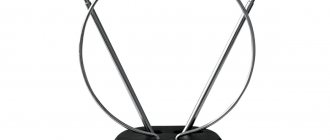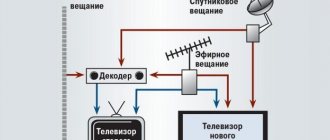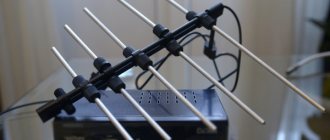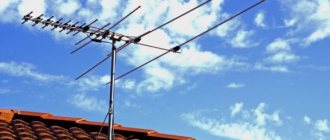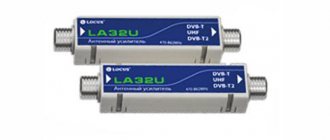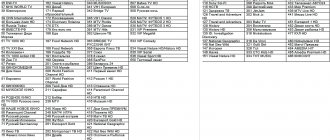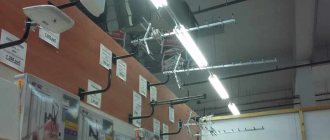Digital terrestrial television is popular among viewers due to the absence of the need to pay for it. The second plus is ease of connection. It is enough to buy an antenna and get a TV with a corresponding tuner or buy the latter separately. Unfortunately, it is not always possible to install an outdoor antenna, but as an alternative, you can use an indoor one. How to choose an indoor antenna for digital TV is described below.
Advantages and disadvantages of indoor antennas
An indoor antenna is a compact device that does not need to be mounted on the roof or in other inconvenient places. They are less efficient than outdoor options, but sometimes the buyer simply does not have the opportunity to install an outdoor device .
Before choosing an indoor antenna for digital television, you should familiarize yourself with the pros and cons.
Advantages:
- low cost;
- easy to install and connect;
- small sizes;
- if necessary, it can be easily removed or moved.
Flaws:
- weak receiver;
- sensitivity to obstacles - trees, buildings, metal poles.
The principle of transmitting and receiving a new TV signal
Let's look at the difference between analog TV and digital TV. With analogue broadcasting, one channel occupies one frequency, while with digital broadcasting, a single frequency can contain a whole package of channels.
Now let's move on to the benefits of using digital TV:
- It works where analog TV does not provide the proper quality of transmissions. The picture on digital television is much brighter and clearer, and interference is much less common.
- The ability to transmit images in different quality formats: it can be a 3D image, HD. And all this with top-notch sound.
- There are additional features that make watching programs much more convenient. Teletext, the ability to vote live, etc. also become available.
- Possibility of purchasing additional content from the operator. This means that in addition to the basic package of channels, you have a paid option. If desired, this service can be activated and disabled.
- Record TV shows with the ability to watch them later.
- Radio.
But there is also a disadvantage of such broadcasting, namely the almost complete absence of a signal in bad weather. The methods of transmitting digital television are terrestrial TV DVB-T2, satellite and cable television.
What types of indoor antennas are there?
If the disadvantages listed above do not bother you, then you should consider what types of indoor television antennas for digital television are available. This is necessary in order to make the right purchase.
- Meter - the simplest type. It catches meter waves. It looks like a box with a transformer hidden inside, and two movable antennae sticking out of it. Such models are not particularly relevant, since only 5 channels are broadcast in the meter range, in addition, a high-quality signal is only possible in close proximity to the signal source. It is not recommended to consider such receivers for purchase.
- Decimeter (frame) – works with decimeter waves. The design has an open frame. Such devices can receive digital TV at a distance of 30 km from the TV tower.
- Hybrid receiver – combines both of the above options. The advantage is that the user can switch from one signal to another if necessary.
- Passive is a weak device that does not have an amplifier to receive the signal. It is characterized by low cost and has a simple design - a box with two antennae for setting the direction of reception.
- Active is a digital indoor antenna with a TV signal amplifier. Requires connection to an electrical network for the amplifier to operate. It costs 2-3 times more than the passive one, but it is capable of working at large distances from the tower, as well as in conditions of a large number of obstacles.
Is it worth buying an amplifier?
Amplifiers for indoor antennas operate on the principle of increasing the pulse of the electromagnetic wave on which the equipment operates, making it more powerful. Simply put, if before using the amplifier the range of the device was significantly lower than after connecting the device to the equipment.
It is important to understand that an amplifier does not improve the quality of the received signal. If there is an excessive amount of noise, the equipment will simply increase the interference received by the antenna, so before purchasing an amplifier you should be absolutely sure of the need for this purchase.
There is also the possibility of receiving an “artifact”. In the language of radio and television broadcasting specialists, this term means a second signal similar in format to the desired one, which is picked up by receiving devices. In other words, the TV will show two images simultaneously.
The cost of an amplifier varies from 500 to several thousand rubles, depending on the power of the device and the manufacturer’s brand.
It is definitely worth purchasing this device for owners of indoor antennas in sparsely populated areas located far from the signal repeater. The main thing is that there are no obstacles on the path between the indoor antenna and the repeater, otherwise the connection will be interrupted and the image quality will be poor.
In other situations, buying an amplifier will be a waste of the user's money.
It is also worth checking whether an amplifier is present in the design of the antenna in question. All active type devices are already equipped with this equipment, so purchasing an amplifier for this type of device to receive a signal will be unnecessary.
Selection rules
Having familiarized yourself with the types and features, you should understand how to choose the right TV antenna, because having bought the first one available, in 99% of cases the user will return to change it to a more suitable option. The user needs to evaluate his installation conditions and, based on this, select an antenna for digital television. The parameters to consider are the following.
- Distance from the repeater.
- The height at which the antenna will be located (meaning the lower or upper floors of apartment buildings).
- Presence of obstacles - high poles, trees, buildings.
- Location in the apartment.
Based on this, the following conclusions can be drawn. For the private sector, located on the outskirts in the direction of TV towers (usually they are installed outside the city, and repeaters are located on high-rise buildings), a passive hybrid or decimeter antenna is suitable.
If the connection is made in a high-rise building on the upper floors, then again you can try to buy a passive receiver, since there will not be any particular obstacles in the form of trees and other buildings.
For lower floors or private houses surrounded by high-rise buildings, you will definitely need to buy an active indoor antenna for digital TV . In addition, it is worth taking a closer look at such an indicator as the receiver power (gain). It is measured in dbi. The higher the indicator, the more distant the signal source will be seen by the device. Sometimes this helps to choose an antenna based on distance, since manufacturers often write down the range next to the coefficient, for example, 30 or 45 km.
Reviews
Here is a selection of some reviews about different models of indoor antennas:
- “I caught 30 channels + 3 radios (19 km from the Ostankino TV tower, 4th floor). Active, powered by receiver or adapter. Thin, compact" (model BBK DA19; https://omegapost.ru/product/bbk-da19.html).
- “We installed it at the dacha, and from the TV tower, which is about 10-15 kilometers away, the antenna picks up all the channels perfectly, the sound is synchronized with the video, there are no interruptions. The connection is extremely simple, it works stably” (model Hyundai H-TAE200; https://omegapost.ru/product/hyundai-h-tae200.html#review).
- “Very good antenna.
I bought it for the dacha instead of an active one. My old one stopped picking up analog, and it doesn’t pick up digital ones at all. I quickly connected it a meter from the ground and sent it to the digital broadcasting tower to check. I caught 20 digital channels and 3 radio stations. The signal power and quality is 95% and this is a meter from the ground. Excellent quality antenna. Everything is fitted with high quality and reliability. Assembly is easy” (model Locus Meridian 07AF Turbo; https://omegapost.ru/product/lumax-da2505p.html#review).
Having considered the topic of choosing an indoor antenna for watching digital television, you can easily choose the antenna that suits you.
Installation and connection tips
For the antenna to work, it must be installed correctly. Before connecting, you should find the best signal reception location. Usually the best reception is next to a window, which is on the same side as the TV tower.
Advice! You can find information for your city on the Internet or look at where street antennas on neighboring buildings are oriented.
If this option does not help (the signal is weak or absent), then you can simplify the search by connecting the receiver to the TV, bypassing the tuner, then open the channel search menu. Many modern TVs display the strength of the received signal. Moving around the apartment, we look for a confident reception. For a high-quality picture, 65% is enough. After this, we leave the antenna in the found location and proceed as follows.
- The cable from the receiver is connected to the DVB-T2 tuner or TV (if it has a built-in tuner) with an antenna cable into the appropriate connector.
- If the antenna is active, then after connecting to the TV it must be connected to the electrical network.
- The last thing to turn on is the TV.
- On TV, select the antenna as the signal source and enter the channel search menu. Select automatic search and wait for the process to complete. Having saved the result, you can watch digital broadcasting.
How to choose a TV antenna?
Content:
Terrestrial television broadcasting Classification of antennas Technical characteristics of antennas Assembly, installation and configuration Tips and examples
ON-AIR TELEVISION BROADCASTING
Terrestrial television broadcasting is called terrestrial because the TV signal is transmitted by a television station into the surrounding space using electromagnetic waves, and anyone can pick up this signal using a television terrestrial antenna.
As a rule, broadcasting is carried out only by local broadcasting television stations in your city, and to them the signal from the studio arrives via cable, satellite channel or other means.
Broadcasting is carried out on meter (MV/VHF) and decimeter (UHF/UHF) waves.
In connection with the transition of the Republic of Belarus to a digital broadcast format, terrestrial television is becoming a convenient and free way to deliver a high-quality television signal. Already now in Belarus more than half of the country can watch digital terrestrial television.
The DVB-T2 standard has been adopted as the main format for digital terrestrial TV in the Republic of Belarus.
In 2015, the entire country switched to DVB-T2 and analogue broadcasting was completely disabled. This must be remembered and taken into account when purchasing new televisions and antennas.
ANTENNA CLASSIFICATION
Television antennas are conventionally divided according to the location of installation, type of signal amplification, and range of received frequencies.
Depending on the installation location - indoor and outdoor.
Indoor antennas , naturally, are installed indoors. It is important to know that reception with an indoor antenna is only possible where the TV signal level is high enough - such places are called areas of reliable reception.
In reality, there are not so many such zones. It is useless to wait for a high-quality “picture” with an indoor antenna in the village, at the dacha and other remote places. Of course, you want to make do with a nice, elegant design, and not climb on roofs and balconies, but there is no way to bypass the laws of physics.
Among indoor antennas, it is worth choosing those adapted to the conditions of Belarusian reception. The best ones will be those in which the design part responsible for receiving the UHF range is directional.
Active antennas look particularly relevant for indoor antennas. It is also desirable to have the ability to smoothly adjust the gain.
The statement that an indoor antenna should receive signals well in any room is completely wrong! Each case should be considered separately and a suitable antenna should be selected.
Outdoor antennas have significantly better parameters and can be used in most places, including country houses and cottages.
Installing an outdoor antenna requires a lot of effort and some experience, but the results will more than pay for your efforts and costs. Outdoor antennas can almost always provide better reception!
By type of signal amplification - passive and active.
Passive antennas receive and amplify the signal due to their design (geometry). They are not connected to the electrical network and do not have active amplification elements: transistors, microcircuits or other electronic components.
Thus, a passive antenna does not introduce its own interference and noise (which is inevitably produced by various electronic components) into the received signal. At the same time, often its own gain is not enough for high-quality reception.
Active antennas amplify the received signal not only due to their design features, but also with the help of an electronic amplifier with which they are equipped. The amplifier can be mounted inside the antenna housing or separately from it. Power is supplied from a household electrical outlet using an adapter (power supply).
It should be remembered that the amplifier is a source of its own noise. In some cases, interference and distortion may be observed in the received TV signal, for example: - when working in an area without a reliable TV signal, - if you choose the wrong amplifier with a very high gain (this is the case when everything is good in moderation!), - when using low-quality amplifiers from unknown companies and manufacturers.
By received frequencies - channel, band and all-wave.
Channel antennas are designed to receive only individual frequency channels and are used in special conditions - for the average TV viewer they are practically never needed.
Band antennas are used where it is necessary to receive only HF, or only UHF. In particular, only the UHF range is used for broadcasting digital terrestrial television in the Republic of Belarus.
All-wave antennas are capable of simultaneously receiving signals from both ranges: VHF and UHF.
ANTENNA SPECIFICATIONS
The antenna, like any electronic device, has a number of parameters and technical characteristics. Some of them are described in the product passport, some - only in technical specifications. It is unlikely that the average buyer needs all these numbers.
Probably the only technical characteristic that the consumer should pay attention to is the antenna gain or gain .
Measured in decibels (dB). The higher the value, the better the antenna’s ability to amplify the TV signal. But as mentioned above, high gain will not always lead to a better image.
The gain must match the antenna installation location!
Sometimes unscrupulous manufacturers or sellers indicate sky-high gain factors on the packaging and in the product data sheet that have nothing to do with reality.
If the antenna shows numbers above 40–45 dB, you should treat this product very carefully. And if you see 80, 90, 120 dB, you are almost certainly being misled. Do not buy!
ASSEMBLY, INSTALLATION AND CONFIGURATION
Purchasing an antenna is not all that is needed to receive high-quality television signals.
The antenna must be correctly assembled, correctly installed, connected and configured.
The assembly is usually described in detail in the product passport or on the packaging. Read the instructions carefully before starting assembly, or better yet, before purchasing! Pay attention to where the antenna is installed, how to connect to the TV and how to achieve the best reception quality.
If in the instructions you see clumsy machine translation, errors and inaccuracies, low-quality and incomprehensible illustrations, do not purchase such an antenna!
The installed antenna must be connected to the TV. This is done using a coaxial cable, which many antennas come with. But if the antenna is purchased without a cable (often an outdoor antenna), or the cable is not long enough, you should take the issue of purchasing it very seriously!
For television antennas, it is necessary to use a cable with a characteristic impedance of 75 Ohms. This number is indicated on the product itself.
The quality of a cable depends on the quality of the materials used and the quality of production. The denser the cable braid and the thicker the central core, the better the cable and, usually, the more expensive it is.
Setting up the antenna most often comes down to its correct orientation towards the television center. The technique is simple - slowly rotate the antenna in a horizontal plane, while simultaneously observing the quality of the received image. When setting up an outdoor antenna, use the help of a second person.
For indoor antennas, when switching TV channels, situations may arise when you need to change the gain or adjust the position of the VHF or UHF parts of the antenna. This is normal and is a kind of payment for placing the antenna indoors.
The configuration of the antenna should be written in detail in its passport.
TIPS AND EXAMPLES
Often the buyer finds it difficult to choose a suitable television antenna. Here, first of all, it is necessary to determine for what purposes the antenna is purchased and what is expected from it, in what conditions it will have to work. Choosing an antenna based only on its appearance can lead to dissatisfaction with a poor-quality image on the TV screen. Here are a few key points that may help:
— If we are talking about receiving a small number of channels, then you can limit yourself to choosing an indoor antenna in the budget segment. But you should be clearly aware that an indoor antenna will often not provide high-quality reception of all channels - this is a compromise option if other options are not suitable at all. Among indoor antennas, it is better to choose directional ones.
— Point the antenna towards the television center.
— If the windows of the room where the TV is installed face the television center, the REMO BAS-5107 MINI Digital window antenna may be suitable for you - it is mounted on glass, and due to this, although it is indoor, in some cases it can compete with outdoor antennas.
— When using a TV with a diagonal larger than 32 inches, you should consider using an outdoor antenna, even despite the desire to use an indoor one.
— The farther the antenna is to be installed from the TV tower, the more gain the antenna will need. At distances greater than 15 km, good reception can be ensured almost exclusively by an outdoor antenna.
Remember! At a short distance from the TV tower, the built-in amplifier will be overloaded with a powerful signal, which can lead to a sharp decrease in the reception of all channels.
— If you plan to connect several TVs to the antenna, you should choose an outdoor antenna with the best parameters.
— If you plan to watch only digital TV, take a closer look at special “digital antennas.”
Remember! Your TV and receiver must receive signals in the DVB-T2 standard.
The following are examples of some typical situations to make it easier for you to navigate when choosing an antenna. However, different places always have different reception conditions, which depend on many factors - there can be no guarantee of 100% quality reception.
If you feel unsure about choosing an antenna, use the help of a sales consultant.
SITUATION 1: Apartment on the top floor of a high-rise building a short distance from the TV station (3–5 km). In addition, the television center is visible from the location where the antenna is supposed to be installed.
The best option here is an outdoor all-wave antenna without a built-in amplifier.
An acceptable level of image quality will be achieved when using almost any indoor antenna. If you choose an indoor antenna with a built-in amplifier, then there must be a gain adjustment to prevent overload with a powerful signal.
When receiving a signal in the DVB-T2 digital format, the image quality should be excellent even on an indoor antenna.
SITUATION 2: Similar to the previous situation, but the windows of the apartment face the opposite side of the television center.
The best option is an external all-wave antenna without an amplifier, installed on the roof and aimed at the television center.
If for some reason this is not possible, you can use a directional indoor antenna (for example, SkyTech DVB-T708, which can be installed both indoors and outdoors). But receiving all channels in good quality is usually impossible.
Again, if the signal is received in the DVB-T2 digital format, the image quality should be excellent.
SITUATION 3: Outskirts of the city, high-rise building, apartment on the ground floor. The distance to the television center is 10–30 km.
The most suitable option is an external active all-wave antenna installed on the roof. In this case, you will need to additionally purchase a coaxial cable, since usually a small amount of cable (6–8 meters) is included with the antenna. It is necessary to choose a high-quality cable with minimal losses, having a dense braid of wires and aluminum foil as a screen. The most commonly used cable is RG-6 or SAT-50.
Old Soviet cables RK-75 have significant attenuation in the UHF range and are practically unsuitable for modern use.
The use of indoor antennas in this case is possible only in the case of low requirements for the quality of the received signal.
In the case of using directional indoor antennas (such as Delta K131A.02) to receive a signal in the digital standard, high-quality reception is possible.
SITUATION 4: A dacha or country house at a considerable (more than 50 km) distance from the television center.
For high-quality reception of all channels, it is necessary to use a professional complex of several band antennas with signal amplification and filtering systems.
If it is acceptable that a high-quality image will not be available on all channels, then you can use an external all-wave antenna with an amplifier.
Indoor antennas are absolutely useless in this case.
Making your own antenna
From a physics point of view, an antenna is a dipole emitter that can simultaneously emit and absorb a signal using an active region (a conductive element). Therefore, you can make it yourself from available items. The most affordable and fastest option is an antenna made from beer cans.
Tin containers are used as the active region and receive the television signal. A cable with a resistance of 65 - 70 Ohms is soldered at the output. Such a device can be easily given any shape that is suitable for installation anywhere. Assembling a receiver from beer cans will take no more than 20 minutes, and it comes in handy when the standard receiver suddenly breaks down, and an interesting premiere or match is about to start.
DIY universal receivers
In sparsely populated areas of remote areas, the situation with television signal reception is the worst. However, the user has complete freedom of space in terms of placement of the receiving device. In these cases, a log-periodic antenna is in demand as a standard receiver. It is all-wave and can receive satellite and terrestrial analog and digital television.
When you need a signal from any existing source (television, Internet, mobile communications), it is recommended to use a Kharchenko antenna. Unlike a log-periodic antenna, it operates only in a specific frequency range, but effectively receives weak signals from any network.
(votes: 1 , average rating: 1.00 out of 5)
Popular questions
As users connected antennas to their TV receivers, the most popular questions were identified.
What is the difference between a “crab” and a coupler?
“Crab” is different in that its power is divided into equal parts between TVs. The taps produce a power distribution of no more than 6 dB. The signal strength depends on the number of connected subscribers. The more there are, the stronger the signal.
In apartment buildings, the connection diagram to a common house television is one large “crab” with many branches.
What determines the quality of a TV signal?
High-quality television signal reception directly depends on the height of the antenna. In addition, the presence of a large amount of serious interference, for example, high-voltage power lines, can have a significant negative impact. This problem can be solved by choosing the right antenna.
When should I buy an antenna amplifier?
An amplifier is used only when the signal strength is not enough to correctly transmit sound and image.
Otherwise, the amplifier may even have a negative effect on your equipment. Over-amplification wears out the equipment, and violations of the correct operation of transmission reception occur, such as channels overlapping each other.
With a consistent approach to the task, users usually easily cope with connecting the antenna to the TV. Having previously selected the desired model of cable, plug and antenna, and determined whether additional devices are needed, you can begin installation.
How useful was the article to you?
Why can't you use regular antennas?
Wideband devices lower the gain by capturing a wider range of frequencies. A deficiency does not always turn into a disaster. Residents of problem regions with a weak signal will have to think about it.
Signal polarization
A constant electric field is not transferred by the ether. Only dynamic systems are characterized by the property of mobility. The world allows a change in the electric field to cause an adequate reaction in the magnetic field. The result is a wave that resembles a New Year's garland twisted and cut along the paper. It narrows and expands.
An electromagnetic wave, if the human eye detects the phenomenon, looks similar. Two school sinusoids, mutually perpendicular. The first chose the horizontal plane, the other - the vertical. One is the amplitude of the electric field, the other is the magnetic field. Polarization is usually divided:
- Vertical.
- Horizontal.
Polarization is characterized by a spatial figure that describes the vector of the electric field amplitude. Owners of smart TVs catch a horizontal or vertical plane (radio). Digital broadcasting uses the simplest waveform.
The polarization formation process is performed entirely by the transmitting antenna. The reception area must have equivalent characteristics. The identity is called electromagnetic compatibility.
The matter is not limited to the considered case; spiral antennas have circular polarization, right-left. Determined by the direction of twist of the turns. Helical antennas are incompatible with linear ones.
Elliptical polarization occurs; circular polarization is considered a special case. You see - simple information. It remains to add that the amplitude vectors of the electric and magnetic fields do not occupy perpendicular planes, rotating continuously. Resembles an image of a human DNA chain.
Frequency band
Let's consider the concept of frequency. The students saw a sine wave. The period of the function is contained in the denominator, the unit is in the numerator, and together the frequency is obtained. Shows the rate of change in the amplitude of electric and magnetic fields. Occupy perpendicular planes. Circular polarization is characterized by frequency; the dependence is more complex.
Real signals differ from sinusoidal shapes. A short time interval allows the field to be viewed approximately (short time). The actual satellite signal occupies a fixed frequency interval. The result is summed up by adding the elementary harmonics (sine waves). The graph represents the process as the dependence of the amplitude of single sinusoids (volts) on frequency (hertz). The representation is called the spectrum of the signal, the occupied horizontal segment is called the frequency band of the signal. Let us add that in digital television harmonics are separated by a strictly defined distance. The spectrum is discrete.
The digital television reception antenna is characterized by polarization and operating frequency band. You cannot use arbitrary modification. It is impossible for one antenna to cover the frequency band occupied by digital television.
